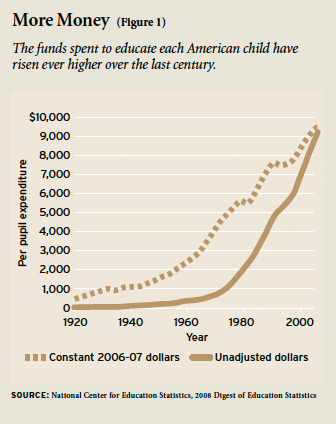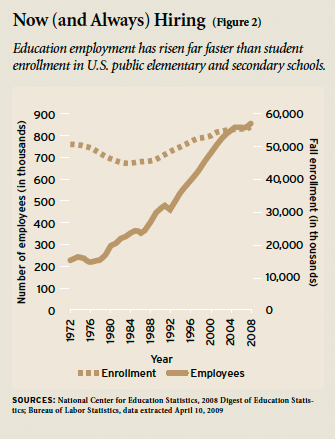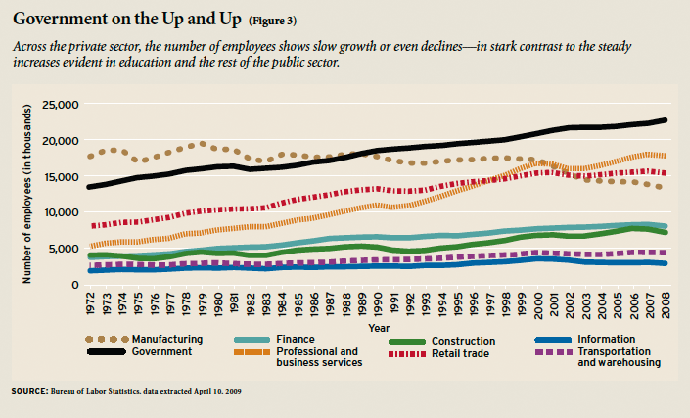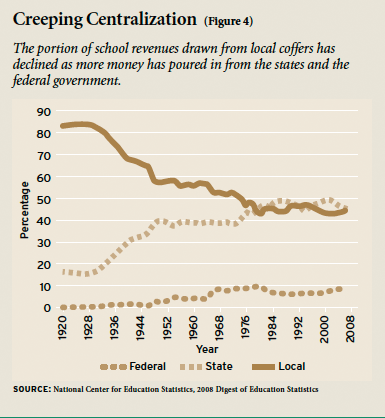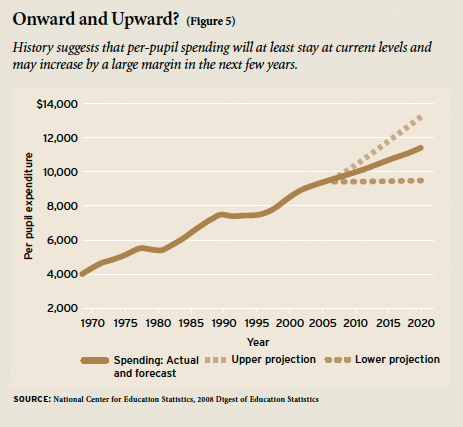 Chicken Little is alive and seemingly employed as a finance analyst or reporter for an education interest group. If one relies on newspaper headlines for education funding information, one might conclude that America’s schools suffer from a perpetual fiscal crisis, every year perched precariously on the brink of financial ruin, never knowing whether there will be sufficient funding to continue operating. Budgetary shortfalls, school district bankruptcies, teacher and administrator layoffs, hiring and salary freezes, pension system defaults, shorter school years, ever-larger classes, faculty furloughs, fewer course electives, reduced field trips, foregone or curtailed athletics, outdated textbooks, teachers having to make do with fewer supplies, cuts in school maintenance, and other tales of fiscal woe inevitably captivate the news media, particularly during the late-spring and summer budget and appropriations seasons.
Chicken Little is alive and seemingly employed as a finance analyst or reporter for an education interest group. If one relies on newspaper headlines for education funding information, one might conclude that America’s schools suffer from a perpetual fiscal crisis, every year perched precariously on the brink of financial ruin, never knowing whether there will be sufficient funding to continue operating. Budgetary shortfalls, school district bankruptcies, teacher and administrator layoffs, hiring and salary freezes, pension system defaults, shorter school years, ever-larger classes, faculty furloughs, fewer course electives, reduced field trips, foregone or curtailed athletics, outdated textbooks, teachers having to make do with fewer supplies, cuts in school maintenance, and other tales of fiscal woe inevitably captivate the news media, particularly during the late-spring and summer budget and appropriations seasons.
Yet somehow, as the budget-planning cycle concludes and schools open their doors in the late summer and fall, virtually all classrooms have instructors, teachers receive their paychecks and use their health plans, athletic teams play, and textbooks are distributed. Regrettably, this story is seldom accorded the same media attention as are the prospects of budget reductions and teacher layoffs.
For a variety of reasons, from one year to the next, schools almost always have more real revenue for each of their enrolled students. For the past hundred years, with rare and short exceptions and after controlling for inflation, public schools have had both more money and more employees per student in each succeeding year. Teacher salaries have increased more than 42 percent in constant dollars over the past half century, while educators’ working conditions, health plans, and retirement arrangements have become ever more commodious. Moreover, school-related revenues and employment levels have increased even when the economy (as measured by Gross Domestic Product or GDP) turned down, unlike what typically happens in sectors such as manufacturing and retail sales, where recessions trigger cutbacks in personnel and profits.
Now, local school funding is apparently more secure than ever before. For the first time in history, the federal government has assumed a dramatic new school-funding role, that of banker of last resort, providing stopgap revenues to the nation’s schools during economic downturns. The Obama administration’s unprecedented injection of billions in federal funding for schools likely ensures that education’s resource cushion will continue for at least the current downturn and possibly for much longer. The notion that the federal government should serve as a fiscal flywheel for schools would have come as a major surprise to lawmakers even during the 1960s’ high point of federal funding for schools.
A Bigger (and Brighter) Backdrop
It is true that occasionally school districts become insolvent and states have to step in and take over. California had a string of costly and highly visible instances in the recent past, with the state having to elbow locally elected school boards aside and install all-powerful administrative overseers in large districts such as Oakland and Richmond. Detroit is the poster child for similar activity in the Midwest (see sidebar). School district insolvencies are rare and most often the result of administrative or school board mismanagement and malfeasance, rather than from the consequence of diminished revenues and systematic budget cuts.
Another Detroit Deficit
A century ago the Detroit Public Schools were among the nation’s leading educational institutions; they now teeter on the edge of oblivion. Enrollments have dwindled to 93,000, roughly half of their 2001 level, as parents have moved or enrolled their children in charter schools. Only 58 percent of enrollees graduate from high school; only
25 percent of 9th graders graduate four years later. Student standardized test scores are among the lowest in Michigan. A Council of Great City Schools report found deficiencies in instruction, data, accounting—the list goes on. The district has 100 vacant schools on its property rolls. The FBI has targeted a school district payroll manager for allegedly embezzling $400,000. When Detroit school employees were asked to pick up paychecks in person, 257 checks were never claimed, presumably made out to ghost employees. A recent audit found staggering waste, from unused vehicles and electronic equipment to health coverage costs for ineligible dependents. In 2002, the Detroit Public Schools had a $103.6 million surplus. Now the district faces a deficit of $259 million and is contemplating filing for bankruptcy protection, a rare occurrence in the history of American public education. More than 2,000 layoffs and 29 school closures have done little to narrow the gap. The district is scheduled to receive $149 million in federal stimulus funds, but only $11 million of this can go toward reducing the deficit.
Nationally, America’s school-district revenues have long been on an upward trajectory (see Figure 1). Since 1929, per-pupil spending has declined only four times and significantly only twice, once during the Great Depression and once in the midst of World War II. There have been 11 periods during which GDP declined but mean total real per-pupil revenues still increased. The number of employees, teachers, administrators, and others has continually increased for four decades, except for the early 1980s period of declining enrollment and recession. And pupil-teacher ratios have fallen by almost 50 percent due to investments in class-size reduction and an increase in the number of teachers who are not assigned to full classrooms (see Figure 2).
How Is Education So Well Protected during Recessions?
Public schools have long been remarkably insulated from economic downturns. This becomes particularly clear when we compare employment trends in different economic sectors. Figure 3 displays historical (1972–2008) employment information in nine sectors: construction, finance, government, information, manufacturing, professional and business services, retail trade, transportation, and warehousing. Employment levels reflect economic conditions and, except for government (which includes elementary and secondary education), employment levels fluctuate with the economy and the historical trend is modestly upward. Contrast this picture with the much steeper upward slopes in education employment shown in Figure 2.
Unlike other employment sectors, education is protected from the direct effects of economic ups and downs by an interlocking and reciprocally reinforcing set of politically constructed conditions. Among these conditions are 1) education’s privileged legal status in most state constitutions; 2) schooling’s uniquely decentralized operation and diffuse revenue-generation structure; 3) local political dynamics and institutions that foster a favorable fiscal environment for public schools; 4) a multitiered structure for funding schools with complicated intergovernmental funding incentives and reliance on inelastic tax sources, such as property taxes at the local level. Almost no other economic endeavor enjoys such a spectrum of insulating conditions.
Constitutional Privilege. The United States Constitution is silent regarding education and schooling. This omission, taken in tandem with the Tenth Amendment’s reservation of unspecified powers to states and the people, and state-level constitutional provisions, renders education principally a state function. Moreover, state constitutions explicitly assume responsibility for provision of schooling.
State constitutional education clauses are generally of three kinds. They assign the legislature a responsibility for provision of an education system that is 1) “Thorough and Efficient,” 2) “General and Uniform,” or 3) the legislature’s “Paramount Duty.”
The precise language of the state constitution is not as important as the explicit specification of the state’s responsibility for providing education. Criminal justice, transportation, recreation, indigent care, economic development, commercial regulation, and even public safety are not privileged to the same degree. A state can decide to pursue or abolish numerous areas of government responsibility, such as support for prisons, highways, parks, and colleges, or welfare payments. It cannot decide to abandon its K–12 school system. Indeed, several states even have constitutional provisions that prevent less being spent on education in any one year than in a prior year.
Many state courts have made clear that education takes priority when it comes to appropriating funds. Adequacy cases decided in favor of plaintiffs in numerous states, such as Campbell County v. Wyoming, have emphasized that the state has a unique obligation to fund schools at high levels, even if other parts of the budget must suffer.
Decentralized Operation. No modern nation has an education system that is more decentralized or multitiered than the United States. The consequence is that American school systems are buffered structurally and politically against resource competition with other state and local governmental services.
Conceived in the colonial period and evolving well into the 21st century, public education in the United States has relied on 50 distinct state systems that, in turn, delegate selected dimensions of operational authority to more than 13,000 local school districts. The majority of these local districts have property taxing authority; the rest rely on county or municipal governments to generate their share of local revenue.
Local school districts are overseen by boards of education. Most of these, 80 percent, are made up of elected members. The remainder of the boards are appointed by mayors, city councils, or other elected authorities. Regardless of membership selection procedures, these boards place education in a privileged position relative to those publicly provided services that depend on general governments for resources and must compete with other services for their share.
Political Protection. General citizen apathy toward school spending and policy can be partially explained by the costs and effort required for active political participation. School policy and operational matters can be complicated. It takes a great deal of personal time to become informed regarding such issues as racial desegregation, charter schools, curriculum content, testing, graduation standards, geographic placement of a new school, and the configuration of attendance boundaries. These and other education-related issues affect parents and educators more than they do other citizens, particularly those citizens who do not have children enrolled in public school.
Hence, school district politics, including those surrounding funding issues and taxation, tend to be dominated by self-interested coalitions of parents and school district employees. For these constituents, the costs of becoming informed and actively participating in school district decisionmaking are low relative to the benefits to be gained. Employee-parent coalitions tend to dominate local school-board elections and ballot measures regarding school funding (see “The Union Label on the Ballot Box,” research, Summer 2006). Their self-interest and favorable predisposition provide schools with political protection against budget cuts when the overall economy turns down.
Several other political elements favor school funding. District employees, those with the most direct interests in sustaining or elevating school spending, are frequently well organized politically. Employee groups can offer sympathetic candidates greater campaign resources than other school-related constituencies. Union members are probably the voters most predisposed to turn out at an election and to vote. These dynamics provide schools and school spending with local advocates who are politically sophisticated and well resourced for campaign purposes.
Opponents of increased school spending or higher taxes for schools can be mobilized and on occasion dominate an election. This was dramatized in the 1978 enactment of California’s famous tax-limitation provision, Proposition 13. Usually, however, incremental increases in proposed school budgets represent only a fractional addition to local property-tax rates. When property owners anticipate paying only a hundred or so additional dollars in the forthcoming year, they may be unwilling to make the effort needed to oppose the increase.
There is an additional political dynamic contributing to the preservation of local school-funding levels. A frequent metric, however misguided, for measuring school quality is the amount of money a district spends per pupil annually. Many posh suburbs actively compete on this dimension, proudly proclaiming their per-pupil-spending status ranking relative to competitor districts. Citizens, parents, and others who have purchased homes in such districts perceive the value of their property to be linked to high spending levels and accordingly acquiesce to advocates’ entreaties for more money.
Finally, in most states, education employee unions have the right to bargain with school boards and to embed collectively derived agreements regarding salaries and working conditions into legally enforceable multiyear contracts. These extended contracts, often bridging or outlasting economic recessions, act to buffer threatened revenue reductions.
Multiple Revenue Sources. Schools are highly resource dependent, but they are not dependent on a single source. The distribution of revenue-raising responsibility over federal, state, and local governments contributes to education revenue stability (see Figure 4).
Three trends of note can be discerned in this graphic. First, one can see that initially, local funds were the dominant source of district revenues, with states and the federal government being only minor partners. In most places, local district and municipal revenue has been generated through property taxation, and this arrangement has assisted in insulating schools from economic ups and downs. Property taxes are relatively inelastic when the economy swings up. It takes assessors two to three years to capture escalating property values and, thus, to give school districts the full measure of benefit from economic growth and housing inflation. However, this same inelasticity protects schools during economic downturns when property owners continue to pay those same taxes, even if their income is reduced, as assessors do not reduce property values in a timely manner.
The second trend began in the post–World War II era, as state funding supplanted and matched or slightly exceeded local revenues. This pattern resulted, at least partially, from the “equal protection” litigation movement launched in the 1970s, in which state courts determined that rectifying once-gaping spending inequalities between districts was the states’ responsibility. While remedies might have left local funding as the principal revenue source for schools, state legislatures chose instead to provide funding centrally from state coffers and to reduce the relative contribution of localities.
Even in the face of the current recession, state governments are raising taxes to cover deficits. This may actually reflect an additional explanation for how well schools have done in the past: States are required to have balanced budgets, so they raise taxes when times are tight and then keep the new rates when the money flows again. Local governments and school districts do not have the luxury of deficit spending.
Reliance on state funds is a double-edged sword, however. State revenues dampen interdistrict inequalities but, since they typically derive from sales and income taxes, these revenues are also more closely linked to economic fluctuation and more volatile than property tax receipts. Dependence on state funding also places education in a more competitive resource arena. Local school boards concern themselves, and focus their taxing authority, only on education issues. State legislatures, education’s privileged constitutional position notwithstanding, have to consider a far wider range of services and responsibilities in deciding who gets what.
The third trend pertains to the federal contribution. In 1965, the federal government launched its most significant education endeavor when the Johnson administration initiated the Elementary and Secondary Education Act (ESEA). Appropriations from this legislation pumped federal spending all the way up to 8 percent of total school revenues. The No Child Left Behind Act (NCLB) is the 2001 version of the ESEA. This statute did not dramatically increase federal funding for education, at least as a percentage of total revenue. It did, however, usher in a completely new era of accountability in education.
Prior to 2009, the highest historical rate of federal contribution to education had been 10 percent. The Obama administration’s economic stimulus plan ($44 billion for schools now flowing under the American Recovery and Reinvestment Act [ARRA] of 2009) dramatically alters this trajectory and contributes to a more evenly balanced revenue portfolio for schools. The federal government is becoming less and less a junior partner, and more and more an equal partner, in the tripartite American method of funding schools.
Why the Ever-Present Fiscal Doom?
If school revenues have enjoyed such remarkable stability, why the persistent appearance of fiscal calamity? One reason is that school-district budget cycles are imperfectly synchronized with state and federal legislative appropriations processes. The fiscal year for state and local governments routinely begins on July 1. It is increasingly rare for legislative bodies to enact spending bills much in advance of this date. School districts are legally obligated to have balanced budgets and cannot balance anticipated expenditures through deficit financing. As local school boards begin their winter and spring budget planning, they and their administrative officers perceive state and federal fiscal uncertainty and publicly discuss, as state “sunshine” statutes mandate, their contingencies for budget cutting.
Since some 80 percent of school-district budgets are absorbed in personnel costs, local school boards, when pressed fiscally, quite naturally give consideration to personnel cutbacks and salary freezes. State statutes make it necessary to inform school employees, usually in April or May, if there are to be layoffs. Sensing financial vulnerability and needing to comply with personnel notification deadlines, school districts issue layoff notices and hold mandatory public hearings, even if the probability of actual personnel layoffs is slender. Such public threats trigger a media frenzy, alarm employees and parent advocates, and exacerbate, yet again, the prevailing public perception that schools are headed for fiscally stringent times.
The likelihood of resource reductions is remote. However, it is a rare education reporter, teacher who receives a layoff notice (however unlikely to be acted upon), or parent who was expecting to have the highly regarded but layoff-vulnerable Ms. Jones for her 3rd-grade child in the fall, who sees the matter in historical perspective or with objectivity.
What Has All This Money Produced?
The ever-increasing cost of public education would engender less controversy if the product had improved apace. The United States expects much of its schools. Preparation for career, college, and citizenship; personal health and hygiene knowledge; racial and gender equity; leisure and aesthetic appreciation; social mobility; scientific sophistication; safe driving practice; and sex, alcohol, drug, reproductive, and environmental awareness are all part of the booming, buzzing, and sometimes antithetical public discourse that assigns purposes to the nation’s schools. Still, there are two fundamental dimensions on which schools must maximize performance in order to make progress toward all other desired education outcomes: 1) children learning to read and 2) students completing high school. Viewed longitudinally, America’s schools have not done well on these dimensions.
Reading scores on the National Assessment of Educational Progress (NAEP) have been level for four decades. Graduation rates, as recently calculated by economist and Nobel laureate James Heckman, display the same regrettable pattern as reading scores. For a half century, nearly one-third of the nation’s high-school students have failed to graduate with their class each year. That average masks much lower historical rates for black and Hispanic students than for white students. Many who do not graduate from high school subsequently obtain high-school equivalency credentials, such as the General Equivalency Diploma (GED). Still, more than 1 million adolescents each year have somehow not been retained by the nation’s schools.
Will the Schools’ Fiscal Privilege Persist?
If one were to place bets based on past evidence, the odds favor America’s public schools to operate next year with at least as much and probably with somewhat more money and a larger and (modestly) better-paid labor force than they had in 2009. The dramatic escalation of the federal government’s revenue contribution, to close to 15 percent of education’s national total, almost guarantees that mean per-pupil revenues will not decline in 2010.
There is no effort here to dispute the reality of the current recession. State and local tax receipts, heavily dependent on consumption and income, were down 4.6 percent for the first quarter of 2009 over the prior year. Still, per-pupil revenues will likely continue their historical upward trajectory. The unprecedented ARRA stimulus recovery allocation for education only strengthens this prediction.
Although the current economic crisis has several dimensions previously unseen—the pace at which employment and housing sectors crumbled, the speed at which credit disappeared, the intensified economic interdependence of global markets, and the stunning magnitude of plummeting personal and institutional wealth—the federal government’s monetary and fiscal recovery plans were enacted into policy with remarkable speed. Congressional willingness to subsidize the economy was never higher. And the international community coordinated stimulus spending as never before.
Also, during early April 2009, the U.S., European, and Asian stock markets seem to have bottomed out and turned up. Job losses, while continuing, are slowing. Nationwide unemployment, at 9.3 percent as of this writing, is still lower than at its post–World War II peak of 10 percent in the 1982 recession, and gives no indication of coming close to catastrophic Great Depression rates. In April 2009, prices of goods and services were down and consumer confidence unexpectedly climbed, modestly, upward.
Balancing all these factors leads to the projections in Figure 5, which provide a bounded estimate of national total operating revenues per pupil through 2020. These high and low projections, based on 2006–07 dollar spending, are the result of calculating historical rates of least and greatest growth and applying those rates to create low and high projections until 2020. Specifically, the low projection, which would produce $9,519 in per-pupil spending in 2020, is based on an average growth rate of 0.1 percent, similar to the period from 1991 to 1996. The high projection, which would produce $13,208 in per-pupil spending in 2020, is based on an average growth rate of 2.45 percent, similar to the period from 1997 to 2004. (Readers should keep in mind that these figures are in 2006 dollars and the actual per-pupil dollar amounts in 2020 would be higher.)
The major assumption here is that the federal government’s stimulus contribution to K–12 schooling will approximate $90 billion. The $37 billion in the stimulus package that is intended to offset reduced state and local education revenue in 2009 will cushion what would otherwise likely have been the first significant per-pupil spending reduction in 60 years.
A New Fiscal Stability
Whether measured on a per-pupil basis or as a percentage of Gross Domestic Product, support for public schools is stronger in the United States than in most other nations. Moreover, this condition has persisted for many decades. A unique set of constitutional, structural, financial, and political arrangements ensures that school systems and professional educators are buffered from revenue losses when the economy declines. State rules surrounding local school-district budgeting procedures contribute to the opposite impression, making it appear that schools are in a perpetual financial crisis.
The 2009 ARRA stimulus package may portend an entirely new source of fiscal stability for America’s schools. When the economy turns down, the federal government may serve as the major fiscal backstop for public education.
James W. Guthrie is professor of public policy and education at Vanderbilt University and director of the Peabody Center for Education Policy, where Arthur Peng is research associate.


